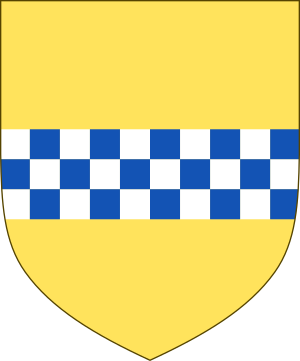Prince of Scotland facts for kids
The Prince and Great Steward of Scotland are two special titles. They belong to the person who is next in line to become the King or Queen of the United Kingdom. Right now, Prince William holds these titles. He also has other Scottish titles like Duke of Rothesay, Earl of Carrick, Lord of the Isles, and Baron of Renfrew.
Contents
Prince of Scotland
The title "Prince of Scotland" began when Scotland was its own kingdom. This was before it joined with England in 1707. The person who was going to inherit the Scottish throne held this title. They also held other titles like Duke of Rothesay and Lord of the Isles. Before Scotland and England shared a king, this title was meant to be like the "Prince of Wales" title in England. It showed who was next in line for the throne.
What is the Principality of Scotland?
The title "Prince of Scotland" started with a special document in 1404. King Robert III gave it to his son, who would later become James I of Scotland. The title became permanent during the time of James III.
The "Principality of Scotland" doesn't mean all of Scotland. It refers to specific lands in the southwest of Scotland. These areas, like Renfrewshire and Ayrshire, were set aside. They were meant to provide money and support for the king's eldest son.
Today, the prince is still the main landlord in these areas. This is similar to how the King or Queen is the main landlord in the rest of Scotland. However, a law passed in 2000 changed things. It removed most of the old feudal duties and special rights linked to the principality. This means the prince's status is now mostly just a title.
Before the 2000 law, these lands were rented out to tenants. This brought in a small amount of money. All title deeds in Ayrshire and Renfrewshire needed the prince's special seal. The money earned from these land dealings went to the Duchy of Cornwall. This is a much larger estate also held by the monarch's eldest son.
Great Steward
The Great Steward of Scotland is also known as the High Steward of Scotland. This was a very important job. The person holding this title managed the royal household's daily business. In the 1100s, King David I of Scotland gave this title to Walter fitz Alan. He was a nobleman from France. His family later took the last name "Steward," which became "Stewart." This family eventually founded the royal House of Stewart.
In 1371, Robert Stewart, who was the 7th High Steward, became King of Scotland. This happened because his mother was a royal heir. When he became king, the job of High Steward became part of the crown.
However, the king then gave the title back to his eldest son. This son was also the heir to the throne. Along with it came other titles like Duke of Rothesay (created in 1398) and Baron of Renfrew (created in 1404). So, today, the Prince of Wales is the Great Steward of Scotland. Sometimes he is called the Prince and Great Steward of Scotland.
Past High Stewards of Scotland
Here are some of the people who held the title of High Steward of Scotland:
- Walter Fitz-Alan, 1st High Steward of Scotland (c. 1150–1177)
- Alan Fitzwalter, 2nd High Steward of Scotland (1177–1204)
- Walter Stewart, 3rd High Steward of Scotland (1204–1246)
- Alexander Stewart, 4th High Steward of Scotland (1246–1283)
- James Stewart, 5th High Steward of Scotland (1283–1309)
- Walter Stewart, 6th High Steward of Scotland (1309–1327)
- Robert Stewart, 7th High Steward of Scotland (1327–1371)
- John Stewart, 8th High Steward of Scotland (c. 1371–1390)
Since 1398, the title of Great Steward has always been held by the Duke of Rothesay.
How the Titles are Used Today
Since James VI became King of England and Ireland in 1603, these Scottish titles are not used as often. The person holding them usually also has other titles like Duke of Cornwall and Prince of Wales. These English titles became more common. Now, the Scottish titles are rarely mentioned, except as the last ones in the Prince of Wales's long list of titles.
In the Scottish Parliament, there's a rule about laws that affect the Prince and Great Steward. Parliament cannot discuss a law that impacts his personal property or interests. This is unless the Scottish Government agrees to it first.
Sometimes, when the King or Queen has no son, it's not clear who should hold these titles. It's also unclear who should receive money from the principality lands. Both Mary, Queen of Scots, and George II of Great Britain used these titles. But when George VI became king, there were different ideas about it. The issue is still not fully settled. However, it's not likely to be a problem for a while.
Images for kids



